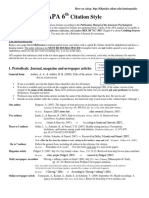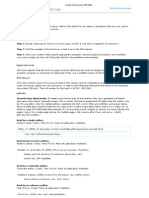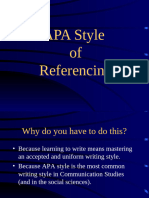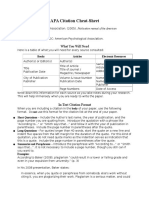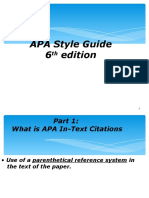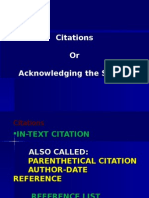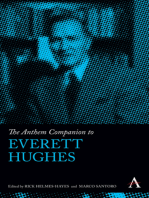0 ratings0% found this document useful (0 votes)
39 viewsA Pa Citation
A Pa Citation
Uploaded by
Hafiz YatinThis document provides guidelines for formatting papers and citing sources in APA style. It discusses formatting papers with proper margins, font, and headers. It also explains how to format the title page and abstract. The document reviews how to cite sources in-text using parenthetical citations, including information about citing different types of sources like books, articles, websites. Examples are provided of both in-text citations and reference list entries in APA style.
Copyright:
© All Rights Reserved
Available Formats
Download as PDF, TXT or read online from Scribd
A Pa Citation
A Pa Citation
Uploaded by
Hafiz Yatin0 ratings0% found this document useful (0 votes)
39 views5 pagesThis document provides guidelines for formatting papers and citing sources in APA style. It discusses formatting papers with proper margins, font, and headers. It also explains how to format the title page and abstract. The document reviews how to cite sources in-text using parenthetical citations, including information about citing different types of sources like books, articles, websites. Examples are provided of both in-text citations and reference list entries in APA style.
Original Description:
apa
Copyright
© © All Rights Reserved
Available Formats
PDF, TXT or read online from Scribd
Share this document
Did you find this document useful?
Is this content inappropriate?
This document provides guidelines for formatting papers and citing sources in APA style. It discusses formatting papers with proper margins, font, and headers. It also explains how to format the title page and abstract. The document reviews how to cite sources in-text using parenthetical citations, including information about citing different types of sources like books, articles, websites. Examples are provided of both in-text citations and reference list entries in APA style.
Copyright:
© All Rights Reserved
Available Formats
Download as PDF, TXT or read online from Scribd
Download as pdf or txt
0 ratings0% found this document useful (0 votes)
39 views5 pagesA Pa Citation
A Pa Citation
Uploaded by
Hafiz YatinThis document provides guidelines for formatting papers and citing sources in APA style. It discusses formatting papers with proper margins, font, and headers. It also explains how to format the title page and abstract. The document reviews how to cite sources in-text using parenthetical citations, including information about citing different types of sources like books, articles, websites. Examples are provided of both in-text citations and reference list entries in APA style.
Copyright:
© All Rights Reserved
Available Formats
Download as PDF, TXT or read online from Scribd
Download as pdf or txt
You are on page 1of 5
APA Citation Style
From the Publication Manual of the American Psychological Association, 6
th
ed., 2009.
Copies of the handbook are available at the WGTC library ready reference desk (BF76.7.P84)
APA citation style refers to the rules created by the American Psychological Association for giving credit to (or acknowledging)
sources of information used in research papers.
Formatting Basics
Your essay should be typed, double-spaced on 8.5 X 11 white paper.
1 inch margins on all four sides.
Use Times New Roman in 12 pt. font size.
Use a page header in the right-hand corner of each page. The header should include the first 2-3 words of the title and
page number.
A title page should be included and should show the header; a running head, which begins with the words Running
head: followed by an abbreviated titled of your paper typed in all caps and typed on the left margin; the full title, your
name, and school name are centered in the upper part of the page.
The page after the title page is the abstract page. The page header should already be on the page. Center the word Abstract
on the first line of the page, do not bold, italics, underline, or place in quotation marks. Beginning on the next line, write a
one-paragraph summary of your research. Do not indent, double-space, be brief.
More information about how to format your paper can be found in the APA manual or ask a librarian.
In-Text Citations
APA uses parenthetical citations in the text of a paper to acknowledge sources of information and to lead the reader to the
complete information about the source in the Reference List at the end of the paper. The APA parenthetical citation includes
three kinds of information: the authors last name, the date of publication of the source being cited, and the page number of any
direct quote. Leave the authors name out of the parenthetical if it is clearly stated in your sentence. Parenthetical citations should
be placed in sentences and paragraphs so that it is clear which material has come from which source. APA style is often used in the
social sciences (such as psychology and sociology at WGTC). Instructors at WGTC may have specific guidelines of their own for
using APA style, so when in doubt whether to use a particular aspect of APA style, check with your instructor.
You should always provide parenthetical citations for the following:
Direct quotes
paraphrases (putting information into your own words)
Summarized material
words specific or unique to the author
use of an authors argument or line of thinking (ideas or theories)
historical, statistical, or scientific facts
articles or studies you refer to in your text
See below for examples of in-text citations.
Examples of Reference List entries and In-text citations
Type of Entry Reference List Citation in Text
Book: single author Smith, J. (1996). Leadership and Women. Boston: (Smith, 1996)
Free Press.
Book: more than one author Hill, M., & Hall, S. (1986). Woman in the car. New York: (Hill & Hall, 1986)
Yale Press.
A work with 3 to 5 authors Smith, H.J., Ti, L., Song, L.G., Hill, B.J., & Lu, L.S. (use all five last names, 1964)
Use all five last names for in-text (2007). A Time to Learn. Atlanta: Georgia Press. (Smith, et al., 1964)
The first time you cite the source,
Subsequent use, list first authors
Last name and et al.
Work in an anthology Thomas, J. (1986). A time to sow. In A. Clarke (Ed.), The (Thomas, 1986)
Early Americans (pp. 159-178). New York: Free Press.
Encyclopedia Hardy, O. H. (2006). Stars. In The new encyclopedia Britannica (Hardy, 2006)
With an author of article (Vol. 2, pp. 236-245). Chicago: Encyclopedia Britannica.
Encyclopedia with no author Stars. (2006). In The new encyclopedia Britannica (Vol. 2, (Stars, 2006)
pp.236-245). Chicago: Encyclopedia Britannica.
Edited book no author Jones, J. C. (Ed.). (1986). Divorce in America: A case (Jones, 1986)
study. New York: Free Press.
Unknown author Divorce in America: A case study. (1986). New York: (Divorce, 1986)
Free Press.
Newspaper article Mardi Gras, again. (2007, Feb. 28). Mobile Press Register, (Mardi Gras, 2007)
(unsigned) p. A5.
Magazine article Jones, W. (1998, June). Id rather travel. Time, 135, 70-72. (Jones, 1998)
Journal article Huff, S., & Hill, M. (1990). The ins and outs of education. (Huff & Hill, 1990)
(continuous pagination) Journal of Special Education, 205, 45-68.
Web site page Jones University. (2006, May 30). Canterbury Tales Clearing (Jones University, 2006)
House. Retrieved June 6, 2007, from: www.jonesu.edu.
Article from GALILEO Clarke, J. S. (1989). Rules for living. Todays Educator 36.7 67-69. (Clarke, 1989)
Database doi 11.1306/0678-6789.32.9.561
Clarke, J.S. (1989). Rules for living. Todays Educator 36.7 67-69. (Clarke, 1989)
Retrieved from http://www.ebscohost.com/asc.html.
Article form encyclopedia Achebe, Chinua. (2008). In encyclopdia britannica online. (Achebe,2008)
in GALILEO(no author) Retrieved from http://search.eb.com/eb/
article-9003521.
eBook from NetLibrary Huppe, B. F. (1964). A reading of the Canterbury Tales. (Huppe, 1964)
Retrieved from: www.galileo.usg.edu. (give full url)
Examples of Parenthetical Citations: APA Style
Type of Citation Example
Authors name in text Jones (1989) states that the case is closed. He goes on to state, this case will not be
reopened (p. 79)
Authors name in citation The report has been changed and cannot be trusted (Jones, 1989). The report was
altered before it was submitted to the courts (Jones, 1989, p.54).
Two authors names in citation All children have the right to the best education available (Jones & Smith, 1998).
3-5 authors: ( in the first reference to The study shows that all children are not receiving equal education (Hill, Jones, Smith,
such a work use all the names, in Clarke, Williams, 2005).
subsequent citations of the same work
use the first authors name followed by et al)
Efforts are being made across the country to ensure equal education to all (Hill et al.,
2005).
Personal communications Because personal communications do not provide recoverable data, they are not
included in the reference list. Cite personal communications in text only.
Page 179 6.20 Manual of the American Psychological Association 6
th
ed.
Ex: name in text: J. C. Jones (personal communication, June 18, 2006) or name not in
text (J. C. Jones, personal communication, June 18, 2006)
Corporate author First citation: (National Park Service [NPS], 2007) Later citations: (NPS, 2007)
Two or more sources cited Several voices (Jones, 2005; Hill, 1999; Smith, 2004) have been heard on this subject.
Author with more than one Since the reader must be able to tell which listing in the reference list matches the
publication in same year citation, add a lower-case letter to the year of publication.
Ex: (Jones, 1999a) for the first published item and (Jones, 1999b) for the second.
Two locations in the same source Huff discusses the plan briefly (2004, p. 69 & p. 72).
Reference to whole volume In the third volume, Clarke (2003, pp. 85-97) tells of his flying adventures.
Two authors same last names Smith admits she has difficulty creating titles for her novels (B. Huff, 2000). She thinks
titles should somehow reflect the content of the novel (D. Huff, 2005).
Work with no author given When there is no author given, use the first two or three words of the title (without
articles) as your in-text citation, capitalize each word.
Ex. Title in sentence: The book Id Rather Travel (1998) states that locals know best.
Ex. Title in citation: To find the perfect hotel consult locals (Id rather, 1998).
Web sources See below for information on crediting web sources.
Examples of Reference page citation: APA Style
Sources of information cited in the text of a research paper must be listed at the end of the paper in a Reference list. The
Reference list provides the information necessary to identify each source that specifically supports your research. In APA style,
references are composed of elements: author, date, title, publication information, and Internet access information. Each element is
followed by a period. A period also goes after all abbreviations or initials, and commas between items in a series. The reference
list is arranged in alphabetical order by lead authors last name. ONLY first and middle initials are used in the authors name. Do
NOT use the given names of authors. Also, titles are written in sentence-case, which means only the first word and proper nouns in
the title are capitalized.
TIPS
Arrange list in alphabetical order by lead authors last name
Use ONLY the first and middle initials of all the authors names
DO NOT use the given names of any author
The year of publication is in parentheses.
Only the first word of all titles (and subtitles)and proper names are capitalized.
Titles of books and names of journals are placed in italics.
Titles of articles are NOT placed in italics.
Use an ampersand (&) instead of the word and when listing authors of a single work.
Publication information: Place of publication is listed first and then the name of the publisher.
Do not drop digits in page numbers: type 1478-1498 not 1478-98.
Internet access: the citation shows all the elements that are used for print sources plus the URL or the DOI.
Italics are used instead of underlining.
A hanging indent is used.
Type of Source Reference page citation
Book: single author Huppe, B. F. (1964). A reading of the Canterbury tales. New York: State
University of New York Press.
Book: two authors Hill, M. & Huff, D. (1968). The tales of Canterbury. New Jersey: Free Press.
Book: three or more authors Hill, M., Smith, J. C., Huff, L. D., & Jones, W. D. (2005). Teaching history.
New Jersey: Crane Press.
Book: corporate author American Society of Mechanical Engineers. (2001). ASME boiler and pressure
vessel code. New York: American Society of Mechanical Engineers
Boiler and Pressure Vessel Committee.
Edited Book Wild, S. (Ed.). (2006). Art in America. New Orleans: Crane Press.
Magazine article Allen, J. T. (1965, February 28). Running the Race. Time, 176 (3), 64-69.
Journal article Wesley, D. D. (2008). The world in crisis: Decision time. Psychological Review,
156 (2), 101-110.
Newspaper article Mardi Gras, again. (2007, Feb. 28). Mobile Press Register, p. A5.
no author
Newspaper article signed Scroggins, A. J. (2007, Feb. 28). Mardi Gras, again. Mobile Press Register, p.
A5.
Article from GALILEO Allen, J. T. (1965, Feb. 28). Running the Race. Time, 176 (3), 64-69. Retrieved
Database from www.galileo.ugs.edu. (give full URL)
Encyclopedia Newson, A. D., & Tice, S. J. (Eds.). (2007). The Harvard dictionary of music and
composers (3
rd
ed., vols. 1-18). Boston: Harvard Press.
Encyclopedia article Taylor, J. D. (2004). Happy music. In The Harvard dictionary of music and
composers (Vol. 15, pp. 368-372). Boston: Harvard Press.
Video recording Bailey, P. B. (Director/Producer), Miller, M. A. (Director), Eubanks, K. A.
(Writer), & Clarke, B. C. (Producer). (2006). The Landing [DVD]. New
Jersey: New Pictures.
Citing a Source from the web or an electronic database
See chapters six and seven of the APA manual for more information on crediting sources and reference examples
In general, it is recommended that the same elements, in the same order, that are used for print sources be included in the citation
of electronic sources. Add as much electronic retrieval information as needed for others to locate sources you cited.
DOI: The DOI is the digital object identifier given to an object. It is used to identify electronic documents.
Type doi at the end of the reference. If there is no DOI, cite the home page URL.
No DOI: If there is no doi give the home page URL. Copy the URL directly from the address window in your browser
into your document so that it will be accurate.
It is not necessary to include database information.
Do not give retrieval dates unless the source of material may change over time. Wikis would be an example of when to
use retrieval dates. Publication Manual of the American Psychological Association: Sixth Edition, 2009: 6.31; 6.32; 6.4
Document from a Web Site Benson, L.D. (2000). The knights tale. Retrieved from Harvard
University: www.courses.fas.harvard.edu/~chaucer/.
West, T. J. (2006). Ready to read. Education Today. 36, 225-227. doi:
08.1112/0278-3316.26.3.636
Allen, J. T. (1965, Feb. 28). Running the Race. Time, 176 (3), 64-69. Retrieved
From www.galileo.ugs.edu. (give full URL)
Examples of in-text citation for web sources: If possible, cite the same as any other document using author-date style. If no
author is shown, use the title in the parentheses. If no page number: use paragraph numbers. Ex: (para.6). Never use the page
numbers of Web pages you print out. Use page numbers if they are from the source not the computer. If no date: (n.d.) is used.
Sources:
Publication Manual of the American Psychological Association 6
th
edition, 2009
Amato, C. J. (2002). The worlds easiest guide to using the APA. Corona, CA: Stargazer Publishing Co.
www.lib.unc.edu/instruct/citations/apa/in_text.html.
www.libs.uga.edu/ref/apastyle.html
www.library.cornell.edu/newhelp/res_strategy/citing/apa.html.
You might also like
- APA Quick Guide - Publication Manual of The American Psychological Association (APA)Document7 pagesAPA Quick Guide - Publication Manual of The American Psychological Association (APA)jesikamosleyNo ratings yet
- The Chicago Guide to Grammar, Usage, and PunctuationFrom EverandThe Chicago Guide to Grammar, Usage, and PunctuationRating: 5 out of 5 stars5/5 (4)
- Citation Style: 1. Periodicals: Journal, Magazine and Newspaper ArticlesDocument4 pagesCitation Style: 1. Periodicals: Journal, Magazine and Newspaper Articlesnnbphuong81No ratings yet
- Citation Style: 1. Periodicals: Journal, Magazine and Newspaper ArticlesDocument4 pagesCitation Style: 1. Periodicals: Journal, Magazine and Newspaper ArticlesFaiz Iqbal FNo ratings yet
- Week 4 RRL Proper CitationsDocument30 pagesWeek 4 RRL Proper Citationsnicki100% (1)
- Summary of Guidelines For Formatting References According To The APA Style Guide: 5th EditionDocument15 pagesSummary of Guidelines For Formatting References According To The APA Style Guide: 5th EditionHanaeeyemanNo ratings yet
- APA Format ReferencingDocument8 pagesAPA Format ReferencingBaquiran, Margaret Joice P.No ratings yet
- Apa Format Internal DocumentationDocument4 pagesApa Format Internal DocumentationsenyorakathNo ratings yet
- Apa Format Internal DocumentationDocument4 pagesApa Format Internal DocumentationsenyorakathNo ratings yet
- APA Citation WebiinarDocument43 pagesAPA Citation WebiinarMoon KimNo ratings yet
- How To Document Sources in APA StyleDocument8 pagesHow To Document Sources in APA StyleFarid FirdausNo ratings yet
- Basic Form: Basics of APA (Purdue OWL) Reference ListDocument14 pagesBasic Form: Basics of APA (Purdue OWL) Reference ListNathaniel AlleyneNo ratings yet
- Rujukan ApaDocument3 pagesRujukan ApaMista VinzNo ratings yet
- Apa Citation Style and Reference ListDocument9 pagesApa Citation Style and Reference ListAbz GaleNo ratings yet
- Citing Sources in Apa, 6 EDDocument2 pagesCiting Sources in Apa, 6 EDanum786110100% (1)
- APA (6 Edition) Referencing Style: CitationDocument4 pagesAPA (6 Edition) Referencing Style: CitationSunday EnoNo ratings yet
- APA Style: How To Cite Sources: Basics of ResearchDocument24 pagesAPA Style: How To Cite Sources: Basics of ResearchFaten AteiaNo ratings yet
- How To Cite Sources - APA StyleDocument21 pagesHow To Cite Sources - APA StyleSamantha G. FerrerNo ratings yet
- Apa Style Manual - 5 Ed.: How To UseDocument4 pagesApa Style Manual - 5 Ed.: How To UseHillel MoraNo ratings yet
- Guide To APA Style Basics: Formatting The Reference ListDocument2 pagesGuide To APA Style Basics: Formatting The Reference ListEnglish Teacher100% (1)
- Preparing BibliographyDocument28 pagesPreparing BibliographyAndrie JacaNo ratings yet
- In-Text Referencing: APA Referencing Style Guide For Non-Electronic SourcesDocument8 pagesIn-Text Referencing: APA Referencing Style Guide For Non-Electronic Sourcestanya_emshNo ratings yet
- Apa Citations and ReferencesDocument4 pagesApa Citations and ReferencesLiezel SanchezNo ratings yet
- ApaDocument3 pagesApasumanlaudariNo ratings yet
- Acknowledging SourcesDocument91 pagesAcknowledging SourcesPatrick Louie RamirezNo ratings yet
- Preparing BibliographyDocument24 pagesPreparing BibliographyLouem GarceniegoNo ratings yet
- Summary of Guidelines For Formatting References According To The APA Style Guide: 6th EditionDocument15 pagesSummary of Guidelines For Formatting References According To The APA Style Guide: 6th EditionTaofan Charlotte EinsteinNo ratings yet
- Quick Tips For ASA Style: PlagiarismDocument2 pagesQuick Tips For ASA Style: PlagiarismMTCNo ratings yet
- Handout - Quick Tips For ASA Style PDFDocument2 pagesHandout - Quick Tips For ASA Style PDFcreamyfrappeNo ratings yet
- APA - Style (1) - 1Document25 pagesAPA - Style (1) - 1priyanshjain1012No ratings yet
- APA 6th EditionDocument5 pagesAPA 6th Editionfazreen fazil100% (1)
- Penulisan Rujukan Format APADocument4 pagesPenulisan Rujukan Format APAShazlipajak PajakNo ratings yet
- APA Citation Cheat-Sheet: What You Will NeedDocument7 pagesAPA Citation Cheat-Sheet: What You Will Needtreeky3100% (1)
- How To Cite References Using APA Style: American Psychological AssociationDocument5 pagesHow To Cite References Using APA Style: American Psychological AssociationElena VicNo ratings yet
- APA Referencing DocumentDocument4 pagesAPA Referencing DocumentMaxmillion NyoniNo ratings yet
- APA Style GuideDocument7 pagesAPA Style GuidebadrunkNo ratings yet
- Apa StyleDocument4 pagesApa StyleShiela MagadiaNo ratings yet
- Citations FormatDocument8 pagesCitations FormatRomy AmistadNo ratings yet
- APA Citation Style (Concordia Libraries)Document10 pagesAPA Citation Style (Concordia Libraries)Uyung YaskurNo ratings yet
- Apa Reference StyleDocument7 pagesApa Reference Stylelalarosario2008No ratings yet
- Chicago Style 08Document4 pagesChicago Style 08jackojidemasiadoNo ratings yet
- APA Formatting and Style GuideDocument46 pagesAPA Formatting and Style Guidekatherina5416No ratings yet
- APA StyleDocument4 pagesAPA StyleNagarajan MaradaiyeeNo ratings yet
- ChartDocument12 pagesChartapi-273079510No ratings yet
- APA Style Guide 6 EditionDocument41 pagesAPA Style Guide 6 EditionFazal HayatNo ratings yet
- How To Do ReferencesDocument53 pagesHow To Do ReferencesUsama KHanNo ratings yet
- Referencing Guide 2012 (APA 6th Edition)Document7 pagesReferencing Guide 2012 (APA 6th Edition)Khai TongNo ratings yet
- 4 Th-LecDocument34 pages4 Th-LecPrincess Zhuhirah IbrahimNo ratings yet
- APA FormatDocument4 pagesAPA FormatMat EyNo ratings yet
- A Study Guide for William Strunk Jr./E. B. White's "Elements of Style"From EverandA Study Guide for William Strunk Jr./E. B. White's "Elements of Style"No ratings yet
- John Steinbeck: The Years of Greatness, 1936-1939From EverandJohn Steinbeck: The Years of Greatness, 1936-1939Rating: 1 out of 5 stars1/5 (1)
- Playing Fast and Loose:: Match Wits with the Author and Guess the Origin of Common IdiomsFrom EverandPlaying Fast and Loose:: Match Wits with the Author and Guess the Origin of Common IdiomsNo ratings yet
- Interpretaciones: Experimental Criticism and the Metrics of Latin American LiteratureFrom EverandInterpretaciones: Experimental Criticism and the Metrics of Latin American LiteratureNo ratings yet
- The Wall Street Journal Essential Guide to Business StFrom EverandThe Wall Street Journal Essential Guide to Business StRating: 5 out of 5 stars5/5 (1)
- Mikhail Bakhtin: Rhetoric, Poetics, Dialogics, RhetoricalityFrom EverandMikhail Bakhtin: Rhetoric, Poetics, Dialogics, RhetoricalityNo ratings yet
- Institut Pendidikan Guru Kampus Sultan MizanDocument9 pagesInstitut Pendidikan Guru Kampus Sultan MizanHafiz YatinNo ratings yet
- Jeremy Smith-The Fall of Soviet Communism, 1986-1991 (Studies in European History) (2005)Document143 pagesJeremy Smith-The Fall of Soviet Communism, 1986-1991 (Studies in European History) (2005)Hafiz Yatin100% (1)
- Competence Knowledge and Skills Application Historical Thinking Among Secondary School Teachers in MalaysiaDocument16 pagesCompetence Knowledge and Skills Application Historical Thinking Among Secondary School Teachers in MalaysiaHafiz YatinNo ratings yet
- The Classical Era 101-700 A.H. Kuala Lumpur: Dewan Bahasa Dan PustakaDocument3 pagesThe Classical Era 101-700 A.H. Kuala Lumpur: Dewan Bahasa Dan PustakaHafiz YatinNo ratings yet
- Be The Best That YOU Can Be! Be The Best That YOU Can Be! Be The Best That YOU Can Be! Be The Best That YOU Can Be!Document3 pagesBe The Best That YOU Can Be! Be The Best That YOU Can Be! Be The Best That YOU Can Be! Be The Best That YOU Can Be!Hafiz YatinNo ratings yet
- Rubric For Your ScrapbookDocument2 pagesRubric For Your ScrapbookHafiz YatinNo ratings yet
- Umayyad Abba Sid ComparedDocument1 pageUmayyad Abba Sid ComparedHafiz YatinNo ratings yet
- Special Rights of BumiputraDocument1 pageSpecial Rights of BumiputraHafiz YatinNo ratings yet
- Gsa1072 Statistik AsasDocument15 pagesGsa1072 Statistik AsasHafiz Yatin100% (1)



